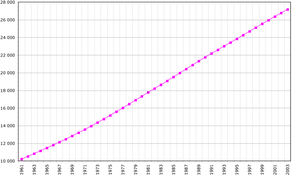Demography of Peru
According to the 10th Inei census, 27,219,264 people lived within Peruvian territory in 2005 . This corresponds to an average population density of 21.1 inhabitants per km², the growth rate is given as 1.4 percent per year. The population of Peru is very unevenly distributed. Around 52.1% of the Peruvian population live in the coastal area (Costa), 36.9% in the Andean region and 11% in the Amazon basin.
About three quarters of the total population (72.3%) lives in cities and one quarter (27.7) in rural areas. Due to the ongoing rural exodus , it is assumed that the proportion of city dwellers will continue to grow in the next few years.
Cities
The most populous cities in Peru are on the Pacific coast. B. Lima , Callao , Trujillo , Piura and Chimbote . In the Andes, the cities of Arequipa , the second largest city in Peru, Cajamarca , Ayacucho , Huancayo and Cusco stand out. In the Amazon basin , Iquitos , Pucallpa and Tarapoto are worth mentioning. Besides Chimbote, all of these cities are also regional capitals.
languages
The most common language in Peru is Spanish, which around 84% of the population speak as their mother tongue. There are also numerous indigenous languages, of which Quechua and Aymara are the most common. In some places, immigrants have retained the language of their respective country of origin. B. German in the Pasco department or Italian in the Junín department. The number of speakers of these languages in Peru is minimal.
religion
The vast majority of the Peruvian population is Christian and one can observe a wide variety of religious festivals and rituals, most of which date back to the Catholic tradition of the Spanish colonial rulers, but there are also many elements of pre-Colombinant cultures. Around 89% of the population is Catholic, around 7% belong to Protestant churches and 6% to other religions.
emigration
It is estimated that in 1980 there were around 1.2 million Peruvians living outside the country. Another 2.2 million Peruvians emigrated between 1980 and 2000. 90% of them went to the United States, Spain, Venezuela, Argentina, Chile, Italy, and Japan.
Counts
- 1st census under President Andrés de Santa Cruz, 1836 (1,873,736 inhabitants)
- 2nd census under President Ramón Castilla, 1850 (2,001,203 inhabitants)
However, the results of the first censuses were very imprecise, as they were influenced by technical and economic instability in addition to technical restrictions. They were carried out in the colonial tradition and were mainly used to estimate tax revenue.
- 3. Mariscal Ramón Castilla's second term census, 1862 (population 2,487,961). The primary aim of this count was to update the electoral roll and the data was only statistically evaluated afterwards.
- 4. Manuel Prado census, May 28, 1876 (population 2,699,105).
Some counters were accused of having acted in a disorganized manner, of having left out places and counting too quickly. For economic reasons, the next count could only be carried out 64 years later:
- 5th census under Dr. Manuel Prado Ugarteche, 1940 (7,023,111 inhabitants)
In 1960 the Congress decided on a 10-year rhythm for future censuses.
- 6th population census, 1st house census and 1st agricultural survey, 1961 (10,420,357 inhabitants, 1,985,859 houses).
- 7th population census and 2nd house census, June 4, 1972 (14,121,564 inhabitants, 3,014,844 houses)
- 8th census and 3rd house census, July 12, 1981 (17,762,231 inhabitants, 3,651,976 houses)
- 9th Census and 4th Housing Census, 1993 (22,639,443 inhabitants, 5,099,592 houses)
- 10th Population Census and 5th Housing Census, 2005
- 11th Population Census and 6th Housing Census, 2007
Web links
Individual evidence
- ↑ El Comercio, Lima, article "El exodo mas acelerado" by Francisco Sanz Gutierrez, page 18, 17/02/2018
